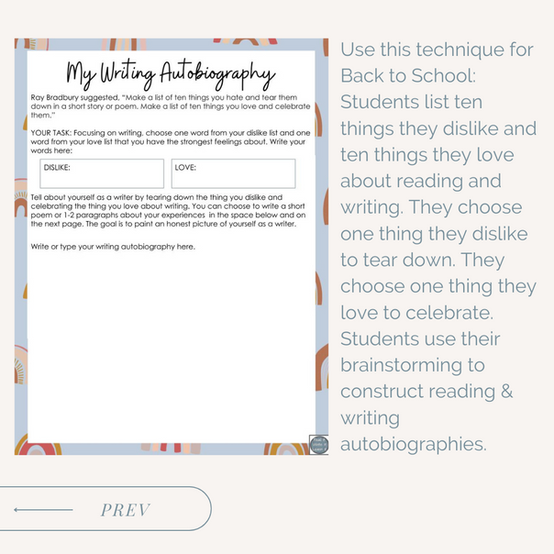Getting started can be the hardest thing for student writers. It's a little too easy to stare at a blank page. Luckily, there are published authors who share their writing and brainstorming techniques to help inspire our students to dive into the magic of the writing process. In a 2010 interview with Sam Weller, published in The Paris Review, author Ray Bradbury described his method of brainstorming the novel Fahrenheit 451:
“Three things are in your head: First, everything you have experienced from the day of your birth until right now. Every single second, every single hour, every single day. Then, how you reacted to those events in the minute of their happening, whether they were disastrous or joyful. Those are two things you have in your mind to give you material. Then, separate from the living experiences are all the art experiences you’ve had, the things you’ve learned from other writers, artists, poets, film directors, and composers. So all of this is in your mind as a fabulous mulch and you have to bring it out. How do you do that? I did it by making lists of nouns and then asking, What does each noun mean? You can go and make up your own list right now and it would be different than mine. The night. The crickets. The train whistle. The basement. The attic. The tennis shoes. The fireworks. All these things are very personal. Then, when you get the list down, you begin to word-associate around it. You ask, Why did I put this word down? What does it mean to me? Why did I put this noun down and not some other word? Do this and you’re on your way to being a good writer. You can’t write for other people. You can’t write for the left or the right, this religion or that religion, or this belief or that belief. You have to write the way you see things. I tell people, Make a list of ten things you hate and tear them down in a short story or poem. Make a list of ten things you love and celebrate them. When I wrote Fahrenheit 451 I hated book burners and I loved libraries. So there you are.”

Ray Bradbury's writing advice is magical. Let's break it down for middle school and high school writers:
1. Empowered Brainstorming: Let students know they have a "fabulous mulch" of ideas living in their heads.
Students often feel like they don't have any ideas and any ideas they do have aren't good enough. Empower students by reminding them as often as possible that they have a story to tell. They are the only people who see the world from their unique perspective. As teachers, we are far removed from the 12-18 year old view of the world. Remind kids of that. We need their perspective and their stories. The world needs their stories. Sometimes that reminder alone is a strong start to inspiring writing.
2. Student Brainstorming Step One: Bring out the ideas by writing a list of ten things they love and ten things they hate.
Instruct your students to write a quick list of nouns representing ten things they love and ten things they hate down the left hand side of a sheet of paper. You might choose to separate the love/hate lists to separate pages. Instruct students to write quickly so the nouns are instinctual--this exercise works best if kids aren't overthinking. To simplify even more, instruct students to put the word "the" before each noun to help ensure they're sticking to a list of nouns vs. other parts of speech.
3. Student Brainstorming Step Two: Ask why.
Once students have their list of nouns, instruct them to use the right hand side of their paper to brainstorm the reasons why they chose each noun. Next to each noun, have them draw a simple line and answer Bradbury's suggested questions: Why did I put this word down? What does it mean to me? Why did I put this noun down and not some other word?
4. Student Brainstorming Step Three: Tear down and celebrate (in writing)!
In his interview, Bradbury suggested that writers "make a list of ten things you hate and tear them down in a short story or poem. Make a list of ten things you love and celebrate them." Instruct students to choose one noun from their list of things they hate and one noun from things they love. Next, instruct your student writers to brainstorm a poem or short story where they tear down the thing they hate and celebrate the thing they love.
Encourage students to try different combinations. Nouns from the love/hate lists could be related or they could be complete opposites. Both combinations could lead to interesting writing.
Most of all, I recommend trying this method yourself. Write on the fly in front of your students working through any struggles in real time and thinking through them aloud. Writing in front of our students not only helps them to see the work of an experienced writer (even if it flops the first few times), but it also helps them to see experienced writers making mistakes and overcoming them with perseverance. The added bonus with listing nouns students and teachers love and hate is that you'll all get to know each other really well!
Let me know in the comments if you try this technique in your classroom. Enjoy!
Curriculum Spotlight: Bradbury's brainstorming technique is part of my Reading and Writing Autobiography activity for back to school. Grab a copy for your classroom here.








